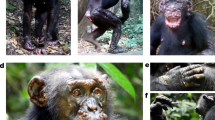Abstract
The age and origins of the organisms that cause syphilis (treponemes) have long been matters for controversy1–3. The widely-held belief that Columbus's ship brought the disease from the New World to Europe rests on identification of the classic lesions in Inca, Aztec and Mississippian bones that date from 1,000 to 3,000 years before present3. But these were not confirmed by immunological techniques. We have observed lesions characteristic of treponemal infection4 in a Pleistocene bear from Indiana (dated 11,500 years BP) which give a positive result when tested with the antisera used by the US Center for Disease Control for verification of syphilis infection. This is the earliest detection of treponemal disease using contemporary techniques.
This is a preview of subscription content, access via your institution
Access options
Subscribe to this journal
Receive 51 print issues and online access
$199.00 per year
only $3.90 per issue
Buy this article
- Purchase on Springer Link
- Instant access to full article PDF
Prices may be subject to local taxes which are calculated during checkout
Similar content being viewed by others
References
Henshen, F. in The History and Geography of Diseases 123–124, 131, 133 (Delacorte, New York, 1962).
Steinbock, R. T. in Paleopathologic Diagnosis and Interpretation, 89–169 (Thomas, Springfield, 1976).
Moller-Christensen V. Abbottempo 1, 20–25 (1969).
Ortner, D. J. & Putschar, W. G. in Identification of Pathologic Conditions in Human Skeletal Remains, 180–218 (Smithsonian Institution, Washington DC, 1981).
Kampmeier, R. H. in Essentials of Syphilology (Lippincott, Philadelphia, 1943).
Resnick, D. & Niwayama, G. in Diagnosis of Bone and Joint Disorders, 2154–2237 (Saunders, Philadelphia, 1981).
Yobs, A. R., Brown, L. & Hunter, E. F. Arch path. Lab. Med. 77, 220–225 (1964).
Handsfield, H. H., Lukehart, S. A., Sell, S., Norris, S. J. & Holmes, K. K. Arch. Derm. 119, 677–680 (1983).
Whitney, J. L. J. Am. med. Ass. 65, 1986–1989 (1915).
Hudson, E. H. in Non-venereal Syphilis: a Sociological and Medical Study of Bejel (Livingston, London, 1958).
Moss, W. L., Bigelow, G. H. Bull. J. Hopkins Hosp. 33, 43–47 (1922).
Helfet, A. J. J. Bone Joint Surg. 26B, 672–681 (1944).
Goff, C. W. in Diseases in Antiquity (eds Brothwell, D. R. & Sandison, A. T.) 170–187 (Thomas, Springfield, 1967).
Dismukes, W. E., Delgado, D. G., Mallrnee, S. V. & Myers, T. C. J. Am. med. Ass. 236, 2646–2648 (1976).
Ziesche, H. MittGrenzeb med. Chir. 22, 357–389 (1910).
Freedman, E. & Meschan, I. Am. J. Roent. 49, 756–765 (1943).
Horwitz, M. A. A. Rheumat. Dis. 7, 200–208 (1948).
Hackett, C. J. Bull. WHO 29, 7–14 (1963).
Turner, T. B. Am. J. Hyg. 25, 477–506 (1937).
Sanchez, F. G., Mazzotti, L. & Salenas, E. G. Salud Publ. Mex. 3, 183–188 (1961).
Author information
Authors and Affiliations
Rights and permissions
About this article
Cite this article
Rothschild, B., Turnbull, W. Treponemal infection in a Pleistocene bear. Nature 329, 61–62 (1987). https://doi.org/10.1038/329061a0
Received:
Accepted:
Issue Date:
DOI: https://doi.org/10.1038/329061a0
This article is cited by
-
Syphilis in a Pleistocene bear?
Nature (1988)
-
Existence of syphilis in a Pleistocene bear
Nature (1988)
Comments
By submitting a comment you agree to abide by our Terms and Community Guidelines. If you find something abusive or that does not comply with our terms or guidelines please flag it as inappropriate.



